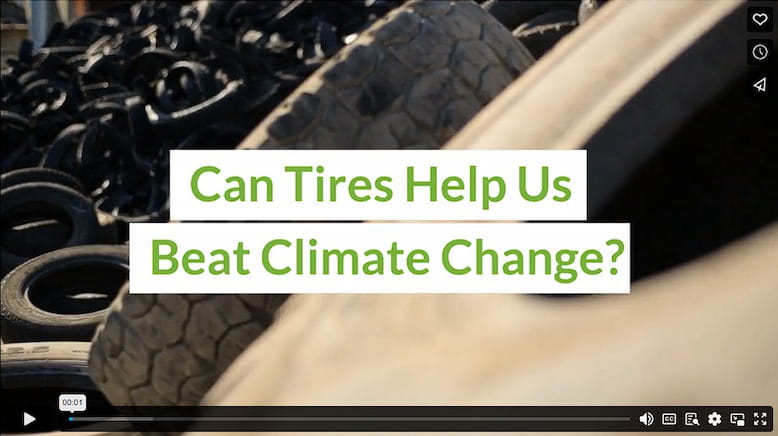Climate change, like some terrifying bully from across the playground, is here, and the consequences are real and devastating. Rising temperatures, changing weather patterns, and increased frequency of natural disasters point to some of the ways in which climate change is impacting our planet.
There are thousands of tips online for reducing your greenhouse gas emissions and carbon footprint. But is the information even worth engaging when so many sources seem to have an agenda in mind? Is it greenwashing, politically motivated, or just misinformation? It’s sadly ironic that the discourse around a cleaner environment so quickly muddies the waters.
This article aims to offer some refreshing facts about how fighting climate change can be a unifying endeavor for us and our industries. How? Well, let’s talk about tires.
Tires as the Universal Good
Okay, ‘good’ has two meanings, and in this context, we’re talking about the goods and services kind of good. The other definition of good is great too, though, and we’ll get to that later.
Tires are like the shoes of our cars, trucks, airplanes, mining equipment, and bicycles. They’re everywhere. Tires provide a vital link between vehicles and the road. Roads link together towns and cities, which are the centers of human activity around the entire planet. In this way, tires link us all together. Even if it’s the singular tire on the front end of a wheelbarrow, we all rely on them in some way or another.
Understanding how to fight climate change with tires provides an excellent example of how to fight climate change generally as a society across borders and political walls.
Tires Don’t Grow on Trees
But they almost do. Tires are made up of a variety of materials, including natural rubber from rubber trees. For durability, manufacturers add steel and nylon.
However, producing tires releases carbon dioxide emissions. Additionally, discarded tires can take hundreds of years to decompose in landfills, which can have negative environmental impacts. Using tires after their useful life span on the road demonstrates how we might use everyday products to curb climate change.
Tire Recycling is a Thing
Yes! And it can help us make climate change less bad.
A scientific report assessing the environmental impact of car tires states, “After the end of the use stage, car tires can be utilized in many ways. In European Union countries, they are usually burnt with energy recovery (40%) or subjected to material recycling involving shredding (38%).” By recycling old tires, we can reduce waste, conserve natural resources, and reduce greenhouse gas emissions.
Tires, like plastics, are ubiquitous across the world. However, unlike plastics, which are light and easy to ship overseas and cause other countries problems, tires must be recycled in nearby tire recycling plants. Otherwise, they end up in landfills and on the sides of roads. This means every country needs tire recycling equipment and tire recyclers.
Tire Recycling Equipment is Awe-Inspiring
If you think Chat GPT is the coolest new technology, that’s likely because you haven’t been exposed to tire recycling machinery.
In the early days of tire recycling, the process was largely manual, with workers using handheld tools to strip the tires of their metal and rubber components. As the industry has evolved, tire recycling machinery has become more advanced, allowing for more efficient and automated processing of scrap tires.
Modern tire recycling machinery can handle a wide range of tire sizes and types and can produce high-quality recycled rubber crumbs or even rubber powder. Imagine mouths that can chew up a whole mining truck tire. Imagine conveyor belts that separate rubber and metal using powerful magnets.
Where Does All the Rubber Go?
Recycling tires is more like reincarnation than resurrection. The materials don’t live the same life again but are used in many other industries.
For example, if you’ve ever won a sports game played on artificial turf, you’ve likely got recycled tire rubber to thank for making that possible. Many cement kilns that would typically be coal-powered burn tires instead, which reduces coal emissions and mining.
There are several tire recycling methods, and each creates unique rubber products. Recycled tires are even used to rubberize asphalt, which can be used to pave roads and make them safer to drive on.
According to the EPA, in 2019, the U.S. generated approximately 290 million scrap tires, but only 81.4% were recycled or used for beneficial purposes. That means that even in the U.S., we need more people to become tire recyclers.
Recycling tires proves that we can reduce waste in our society in almost every industry. It conserves natural resources and reduces greenhouse gas emissions simultaneously. It’s like a domino effect of environmental goodness. And so we see that by recycling old tires, we can help mitigate the effects of climate change. Slowing down climate change is a good thing to do. So maybe tires lead us to the universal good in that way too.
Infographic
Climate change poses severe and tangible threats to our world. Tires, surprisingly, become allies in the fight against it. Despite being a universal good, tire production emits carbon. Recycling, with methods like energy recovery and material recycling, addresses this. Recycled tire rubber finds new life in industries such as sports turf, cement kilns, and road construction. By actively participating in tire recycling, we contribute to addressing climate change, emphasizing the importance of confronting this global challenge.

Video





